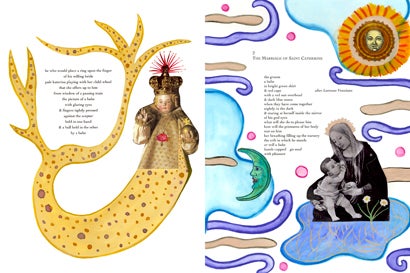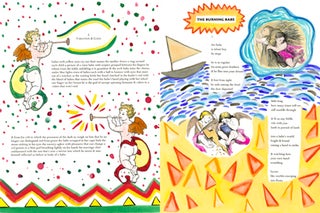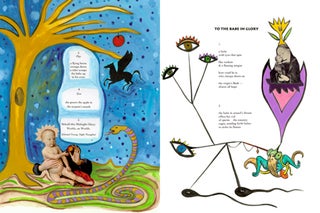The Burning Babe & Other Poems.
Granary Books, 2005. Item #GB_131
9 x 12 in., 36 pp., cloth over boards, dust jacket.
“I’ve long been aware of the variations on religious imagery & symbolism in painterly & folkloric sources—some of them extreme & much too numerous to outline here. Of these the figure of the infant-god as world ruler has seemed to me both terrifying & crazed in its specific manifestations. As the ‘babe poems’ emerged for me along those lines, I began to think of presenting them in an illuminated work that would not so much illustrate them as extend them into a different but intellectually compatible genre. Their realization by Susan Bee answers precisely to the book I had in mind.”
–Jerome Rothenberg
“The Burning Babe and Other Poems is a full-color setting of a series of poems, taking off from the images of babies and angels in European Renaissance and medieval art and also touching on other themes such as Kurt Schwitter’s Merzbau. Many of the settings of the poems in this book were influenced by the illuminated books of William Blake and also medieval and Renaissance book illuminations. The book uses collage with watercolor, ink, crayon, cut colored paper, and gouache drawings as the backdrop for the poems. Each page includes visual elements that are referred to on the poems on that page. For instance, one page features a flying horse, a baby grasping an apple, and a serpent. These are all elements that are referred to in the poems that are printed on this page. The poem ‘Italy 1999’ features a rainbow and a feathered serpent and here a cut-up rainbow is used to set off the words of the poem. The last section of the book and poem deals with Kurt Schwitter’s lost project, his large-scale installation, the Merzbau, that was destroyed in World War II. Here I used cut colored papers to form the context for this poem. The use of cut paper refers to Schwitter’s own use of collage. On the next to last page of the book, there is a uniting and summary of all the themes from this book including the Madonna and Child, the image from the photo of the Merzbau above, clocks, and a reference to New York City and 9/11 below with the image of the Brooklyn Bridge. I see the illustrations as an enhancement of the text, not a superseding of the text. But as a way to provide a further key to reading the poems. In effect, this is my way of reading the poems for myself. The settings also form a comment on the text bringing out certain elements that appealed to me as visual elements.”
–Susan Bee
Printed digitally on Innova smooth white 100% cotton paper using pigment inks at Silicon Gallery Fine Art Prints in Philadelphia during the summer of 2005. Bound in printed orange cloth over boards by Judith Ivry. This is from an edition of 41 copies of which 16 are hors commerce and 25 are for sale. As new.
●
ABOUT JEROME ROTHENBERG
ABOUT SUSAN BEE
Complete text of book available at University of Pennsylvania Electronic Poetry Center.
Out of Stock





